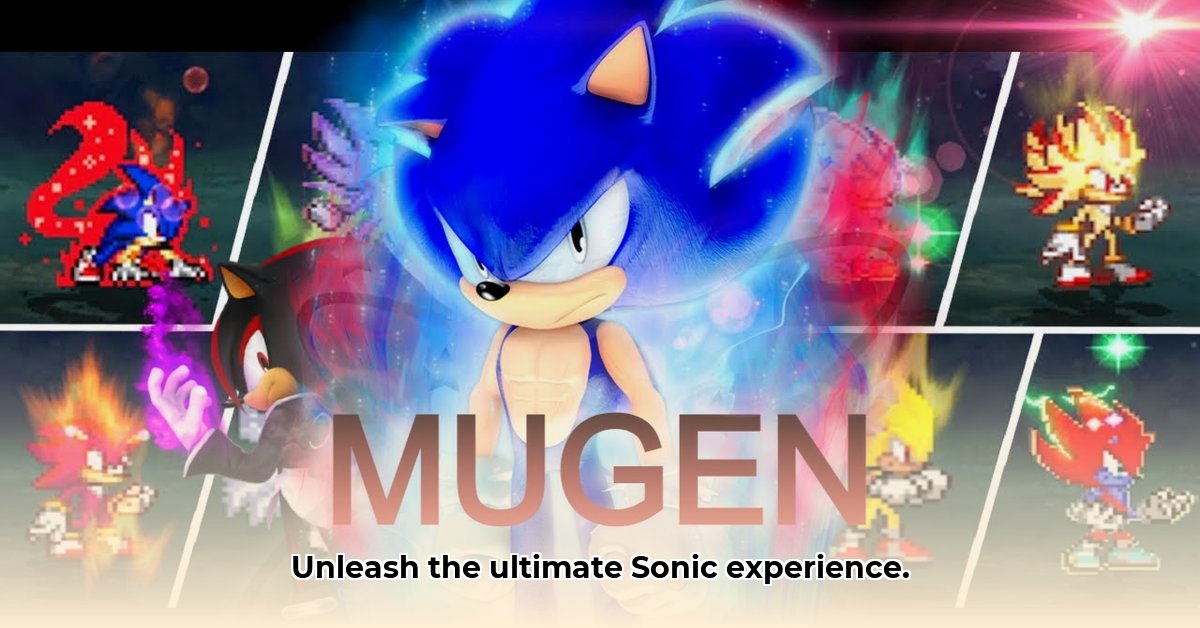
A World Built by Fans, For Fans
Sonic Mugen isn't your average Sonic game; it's a sprawling universe of fan-created fighting games built using the MUGEN engine (a widely used 2D fighting game engine). This isn't just about playing; it's about participating in a passionate community united by a love for the blue blur. Expect a wildly diverse range of experiences, from simple, charming creations to surprisingly sophisticated titles, all crafted within this unique digital ecosystem. To get started, download the MUGEN engine from here.
From Humble Beginnings to Pixel-Perfect Worlds
Sonic Mugen's journey mirrors the MUGEN engine's evolution. Early fan games were rudimentary, featuring simple graphics and straightforward mechanics. However, as the engine advanced and the community honed its skills, the quality leaped dramatically. Witnessing this grassroots development is truly remarkable – a testament to collaborative effort and increasing technical prowess. What began as small, simple projects has blossomed into a diverse collection of games, many boasting impressive graphics and refined gameplay mechanics.
The Community: A Collaborative Tapestry
The Sonic Mugen community isn't monolithic; it's a vast network of individuals contributing distinct skills. There are pixel artists meticulously crafting character sprites, programmers toiling away on complex AI and engine modifications, and dedicated testers ensuring smooth, enjoyable gameplay. This teamwork fuels innovation, yet concurrently presents challenges. The community's decentralized nature, spread across multiple online platforms, hinders effective communication and collaboration. A centralized hub could significantly enhance community cohesion and resource sharing.
A Galaxy of Sonic Adventures: From Classic Remakes to Wild Originals
The sheer variety of games is astounding. Some meticulously recreate classic Sonic levels and characters, while others boldly reinvent the Sonic universe with entirely original narratives, characters, and gameplay mechanics. This spectrum reflects the diverse skill levels within the community. Consider these categories:
| Category | Description | Examples |
|---|---|---|
| Classic Remakes | Recreations of levels and characters from classic Sonic games. | Diverse re-imaginings of Green Hill Zone and beyond |
| Original Adventures | Games with completely new stories, characters, and worlds. | Novel story-driven games with unique characters |
| Crossover Creations | Games blending Sonic characters with those from other franchises. | Sonic collaborating with (or battling) other universes |
| Technical Showcases | Games showcasing impressive engine capabilities and innovative techniques. | Stunning examples of animation and detailed sprites |
Do you ever wonder what factors contribute to the vast differences in quality among these projects? It's a fascinating area for exploration.
The Future: Navigating Challenges and Embracing Opportunities
The future of Sonic Mugen presents both exciting potential and significant hurdles. The engine's limitations and ever-present copyright concerns remain ongoing challenges. However, the community's passion and creativity are powerful assets. Enhanced collaboration among developers, more ambitious joint projects, and even potential partnerships with Sega could propel the community forward. The prospect of official Sega support could be transformative, elevating Sonic Mugen to new heights. What are the biggest challenges facing Sonic Mugen's future? Maintaining a vibrant community, while addressing legal concerns, seems critical.
How to Create High-Quality Sonic Mugen Fan Games
Key Takeaways:
- MUGEN offers a relatively accessible entry point for creating custom fighting games.
- Mastery of the engine’s file structures, particularly the
select.deffile, is crucial. - High-quality assets are paramount for a polished final product.
- Community collaboration and resource sharing accelerate development.
- Strict adherence to copyright laws is essential.
A Brief History: From Humble Beginnings to Modern Marvels
Sonic Mugen's evolution demonstrates the power of community-driven game development. Starting with simple modifications, the community’s efforts transformed into ambitious, intricate projects. Early games, though rough, highlighted the potential. Over time, the community refined its tools and techniques. The result? Some Sonic Mugen projects now showcase incredible artistry and technical skill. The inherent diversity, however, remains a defining feature, offering both potential and challenges.
Understanding the Engine: Mastering the Tools
Before embarking on your project, you need the right tools. This starts with downloading the MUGEN engine itself. A screenpack (which provides the game’s visual style) – such as IMT, known for its user-friendliness – forms the visual foundation. High-quality character and stage assets are also critical; luckily, the community often shares these resources freely. The select.def file, a seemingly simple text file, dictates which characters and stages appear in the game selection screen. Mastering its structure is fundamental for building a successful game.
Building Your Game: A Step-by-Step Guide
- Gather your assets: Download MUGEN, a suitable screenpack, and your chosen characters and stages.
- Organize your files: Employ a well-structured folder system for efficient workflow.
- Modify the
select.deffile: Define character and stage order and appearance in the game's roster. - Thoroughly test: Playtest regularly, identifying and resolving bugs and glitches.
- Seek feedback: Share your game with others for constructive criticism.
Critical Analysis: A Spectrum of Quality
Sonic Mugen boasts a wide range of quality. Some games are polished gems, while others fall short. Graphics and gameplay vary significantly. Exceptional examples demonstrate the engine's potential, showcasing stunning animation, original game modes, and unique storylines. Conversely, poorly made games can suffer from clunky controls and uninspired visuals. The key lies in prioritizing high-quality assets, a well-structured game design, and thorough testing.
The Future of Sonic Mugen: Collaboration and Innovation
The future is bright, provided the community sustains its collaborative spirit. More structured collaboration could significantly enhance game quality. Improved documentation and organized community resources would lower the barrier to entry for new developers. The development of tools to simplify the creation process would be invaluable. The potential for larger, more complex projects is vast. However, addressing legal issues, particularly copyright concerns, is paramount for long-term sustainability. The journey of Sonic Mugen is a fascinating example of community-driven creativity.
⭐⭐⭐⭐☆ (4.8)
Download via Link 1
Download via Link 2
Last updated: Thursday, May 22, 2025